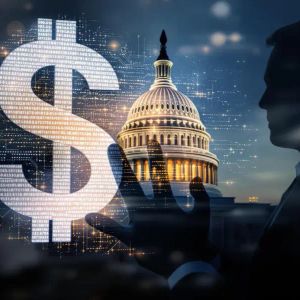Cardano Transaction Fee Shock: Unpacking the Astonishing $3 Million Blunder
10 min read
BitcoinWorld Cardano Transaction Fee Shock: Unpacking the Astonishing $3 Million Blunder In the fast-paced world of cryptocurrency, where transactions typically cost mere pennies, news of an exorbitant fee can send ripples of astonishment across the globe. Imagine sending a digital asset and inadvertently incurring a charge equivalent to a luxury mansion or a small private jet. This isn’t a hypothetical scenario; it recently became a reality for a single Cardano (ADA) transaction, sparking widespread discussion and raising questions about the intricacies of blockchain transaction costs . According to the renowned blockchain tracking service, Whale Alert , a singular Cardano transaction was executed that shockingly included a fee of 3,700,001 ADA. At the time of the report, this staggering amount was valued at approximately $3.03 million. Such an event is exceptionally rare and immediately grabs headlines, prompting the crypto community to delve deeper into what could possibly cause such an astronomical charge on the usually efficient ADA network . What Exactly Happened with This Massive Cardano Transaction Fee? The report from Whale Alert , widely shared across social media platforms like X (formerly Twitter), highlighted a transaction that, on the surface, appeared to be a standard movement of funds. However, the accompanying fee component was anything but standard. For context, typical Cardano transaction fees are famously low, often less than a single ADA, and frequently just a fraction of a dollar. This makes the $3 million fee an anomaly of epic proportions, an outlier that stands in stark contrast to the network’s design principles. The transaction details, as publicly available on the blockchain, confirmed the colossal fee. This wasn’t a case of a large transfer of ADA itself, but specifically the fee associated with the transfer that ballooned to an unprecedented sum. The immediate reaction from the community ranged from disbelief to theories about potential errors or highly unusual circumstances. It served as a stark reminder that even in the decentralized world, vigilance is paramount when dealing with digital assets and their associated blockchain transaction costs . Understanding the ADA Network’s Fee Structure To truly grasp the magnitude of this incident, it’s crucial to understand how fees are typically structured on the ADA network . Cardano’s fee model is designed to be predictable and low, ensuring accessibility and scalability for its users. Unlike some other blockchains where fees can skyrocket due to network congestion (think Ethereum’s gas fees during peak times), Cardano employs a fixed base fee plus a variable component based on the transaction size in bytes. Base Fee: A small, fixed amount (e.g., 0.17 ADA). This covers the basic cost of processing any transaction. Variable Fee: Calculated based on the size of the transaction in bytes. The larger or more complex the transaction (e.g., involving multiple inputs/outputs, smart contracts), the slightly higher this component will be. This model ensures that even complex transactions involving smart contracts or multiple outputs remain relatively inexpensive. For instance, a standard ADA transfer usually costs less than 0.2 ADA. So, how could a Cardano transaction fee jump to 3.7 million ADA? This disparity is what makes the incident so perplexing and points towards an extraordinary, rather than ordinary, cause. The purpose of crypto fees across any blockchain is multi-faceted. They deter spam attacks by making it costly to flood the network with junk transactions, incentivize network participants (like validators or stake pools in Cardano’s case) to process transactions, and contribute to the overall security and stability of the decentralized ledger. However, a fee of this size far exceeds any reasonable operational cost or security incentive. Why Such an Astronomical Blockchain Transaction Cost? When an event of this magnitude occurs, the crypto community immediately begins to speculate on the underlying causes. Given the robust and predictable nature of the ADA network ‘s fee structure, a systemic flaw is highly improbable. Instead, the most plausible explanations revolve around human error or highly unusual, intentional circumstances. Common Theories Explored: Fat-Finger Error or Decimal Misplacement: This is by far the most widely accepted and likely explanation. In the digital realm, a misplaced decimal point or an extra digit can have catastrophic consequences. It’s plausible that the sender intended to pay a fee of, say, 3.7 ADA or 37 ADA, but mistakenly entered 3,700,001 ADA. Such errors, while rare, do occur, especially with large sums or when users are manually inputting values into a wallet interface. Imagine typing 3.7 instead of 0.37, but on a much larger scale, or adding an extra ‘000’ unintentionally. This kind of error highlights the critical importance of careful review before confirming any blockchain transaction, especially given the irreversible nature of these operations. Once confirmed and broadcasted, there’s no ‘undo’ button. Intentional Overpayment (e.g., ‘Burning’ or Donation): While less likely for such a specific, odd number, some users might intentionally send funds to an unspendable address or pay an exorbitant fee as a form of ‘burning’ tokens or making a public, dramatic statement. However, the precise figure of 3,700,001 ADA doesn’t immediately suggest a round-number ‘burn’ or a typical donation. If it were a deliberate burn, it would more likely be a round number or a significant percentage of a holding. Exchange or Custodial Service Glitch: Automated systems handling large volumes of transactions for exchanges or institutional custodians could, in rare instances, experience a bug. If an automated script miscalculated a fee or pulled an incorrect value, it could lead to such an outcome. However, major exchanges have robust testing and error-checking mechanisms in place precisely to prevent such costly mistakes. If this were the case, it would likely prompt a public statement from the affected entity. Smart Contract Anomaly: While the transaction appeared to be a simple transfer, complex smart contracts can sometimes have unforeseen interactions or require specific fee structures. However, for a direct ADA transfer, this is generally not the case. If it were related to a smart contract, the fee structure would typically be defined within the contract’s logic, making such an error less probable unless the contract itself was flawed or exploited. It’s important to note that when such a high Cardano transaction fee is paid, the ADA doesn’t vanish into thin air. In Cardano’s system, a portion of transaction fees is sent to the project’s treasury, and another portion is distributed to stake pools as rewards for validating transactions. So, while the sender incurred a massive loss, the funds were absorbed by the network’s ecosystem, benefiting its long-term development and security, albeit in an unintended and highly unusual manner. Implications for the Cardano Ecosystem and User Trust An incident involving such a colossal blockchain transaction cost naturally raises questions, particularly for newcomers to the crypto space. Does this mean the ADA network is unreliable or prone to high fees? The answer is a resounding no. This event is an extreme outlier and does not reflect the typical user experience on Cardano. The network remains one of the most cost-effective and energy-efficient blockchains available. In fact, Cardano’s consistent low fees are a core tenet of its design, aimed at fostering widespread adoption and enabling microtransactions that would be economically unfeasible on networks with volatile or high crypto fees . However, such news can momentarily affect public perception. It underscores the need for clear communication and education within the crypto community. While the incident was almost certainly a user error, it highlights the immutable nature of blockchain transactions. Once confirmed, they cannot be reversed, emphasizing the importance of user responsibility and careful verification. The robust monitoring by entities like Whale Alert , which quickly flagged this anomaly, also reinforces the transparency inherent in public blockchains. Every transaction is recorded and verifiable, allowing for immediate scrutiny and analysis of unusual activity, which ultimately contributes to the network’s integrity and accountability. Navigating Crypto Fees: Best Practices for Secure Transactions While the $3 million Cardano transaction fee is an extreme case, it serves as a powerful cautionary tale and a reminder of best practices when dealing with crypto fees and any digital asset transaction. Protecting your funds and ensuring smooth operations requires diligence. Actionable Insights for Users: Best Practice Description Why it Matters for Blockchain Transaction Costs Double-Check All Details Before confirming any transaction, meticulously review the recipient’s address, the amount being sent, and the associated fee. Many wallets offer a confirmation screen. Prevents errors like misplacing decimals or entering incorrect amounts, which can lead to excessive fees or sending funds to the wrong address. Understand Fee Structures Familiarize yourself with how fees are calculated on the specific blockchain you are using (e.g., Cardano, Ethereum, Bitcoin). Helps you anticipate costs and recognize unusually high or low fee requests, signaling a potential issue. Use Reputable Wallets/Exchanges Opt for well-known, audited, and user-friendly wallets or exchange platforms. These platforms often have built-in safeguards, clear fee displays, and robust security features to minimize user error and protect assets. Start Small for New Addresses When sending funds to a new or unfamiliar address, consider sending a small test transaction first. A negligible fee for a test transaction is a small price to pay to ensure the address is correct and the transaction goes through as expected before sending larger amounts. Stay Informed About Network Conditions While less common on Cardano, other networks can experience congestion leading to higher fees. Staying updated helps you choose optimal times for transactions. Helps in planning transactions to avoid periods of high network demand and inflated blockchain transaction costs . By adhering to these simple yet crucial practices, users can significantly mitigate the risk of accidental overpayments or other costly mistakes, ensuring their experience with the ADA network and other blockchains remains positive and cost-effective. The Role of Whale Alert in Blockchain Transparency The news of the $3 million Cardano transaction fee came to light thanks to Whale Alert , a service dedicated to tracking and reporting large cryptocurrency transactions. Their role in the ecosystem is invaluable, providing a layer of transparency and insight into the movements of significant amounts of digital assets. Whale Alert continuously monitors various blockchains, flagging transactions that meet certain thresholds in terms of value. This service helps the community: Identify Market Trends: Large movements to or from exchanges can signal potential buying or selling pressure. Spot Unusual Activity: Like the Cardano fee incident, anomalies are quickly brought to attention, prompting investigation. Enhance Transparency: By making large transactions visible, Whale Alert contributes to the overall openness of public blockchains, allowing anyone to verify significant transfers. Track Major Players: It provides insights into the activities of large holders, or ‘whales,’ whose moves can influence market sentiment. Without services like Whale Alert , such a significant and unusual crypto fee might have gone unnoticed by the broader public, or at least taken much longer to be identified and discussed. Their swift reporting ensures that the community is kept abreast of critical on-chain events, fostering a more informed and vigilant ecosystem. Summary: A Rare Glitch, Not a Systemic Flaw The single Cardano transaction that incurred a shocking $3 million fee stands as a stark reminder of the immutable and often unforgiving nature of blockchain transactions. While initially alarming, it is overwhelmingly considered to be an isolated incident, most likely attributed to a human error such as a misplaced decimal or an accidental input of an extra digit. This extraordinary Cardano transaction fee is not indicative of the typical blockchain transaction costs on the ADA network , which remains celebrated for its low and predictable fees. The swift reporting by Whale Alert highlighted the transparency inherent in public blockchains, allowing the community to quickly identify and analyze such anomalies. This incident, while costly for the individual involved, serves as a powerful educational moment, underscoring the critical importance of vigilance, double-checking transaction details, and understanding the fee structures when navigating the world of crypto fees . As the Cardano ecosystem continues to grow, such rare occurrences reinforce the need for user education and robust wallet interfaces to prevent similar blunders, ensuring the network remains a reliable and cost-effective platform for all its users. Frequently Asked Questions (FAQs) Q1: What is a Cardano transaction fee? A: A Cardano transaction fee is a small amount of ADA paid by the sender to execute a transaction on the Cardano blockchain. It consists of a fixed base fee and a variable component based on the transaction’s size in bytes. These fees contribute to network security and reward stake pools. Q2: Why was this specific Cardano transaction fee so high ($3 million)? A: The $3 million fee was an extreme anomaly. The most likely explanation is a significant human error, such as a misplaced decimal point or an accidental entry of an excessively large number in the fee field, rather than a systemic issue with the Cardano network. Q3: Who benefits from such a high transaction fee on Cardano? A: On Cardano, transaction fees are distributed within the network. A portion goes to the Cardano treasury, which funds development and community initiatives, and another portion is distributed among stake pools as rewards for validating transactions and securing the network. So, the network itself benefits from the unintended overpayment. Q4: How can I avoid paying excessive crypto fees? A: To avoid excessive crypto fees, always double-check all transaction details (recipient address, amount, and fee) before confirming. Use reputable wallets with clear fee displays, understand the fee structure of the blockchain you’re using, and consider sending a small test transaction for new addresses. Q5: Is the Cardano network generally expensive to use? A: No, the Cardano network is known for its very low and predictable transaction fees. A standard ADA transfer typically costs less than 0.2 ADA, making it one of the most cost-effective and accessible blockchains for everyday transactions and smart contract interactions. To learn more about the latest crypto market trends, explore our article on key developments shaping Cardano’s price action and institutional adoption. Did you find this article insightful? Share it with your friends and fellow crypto enthusiasts on social media to spread awareness about blockchain safety and the fascinating world of crypto transactions! This post Cardano Transaction Fee Shock: Unpacking the Astonishing $3 Million Blunder first appeared on BitcoinWorld and is written by Editorial Team

Source: Bitcoin World



